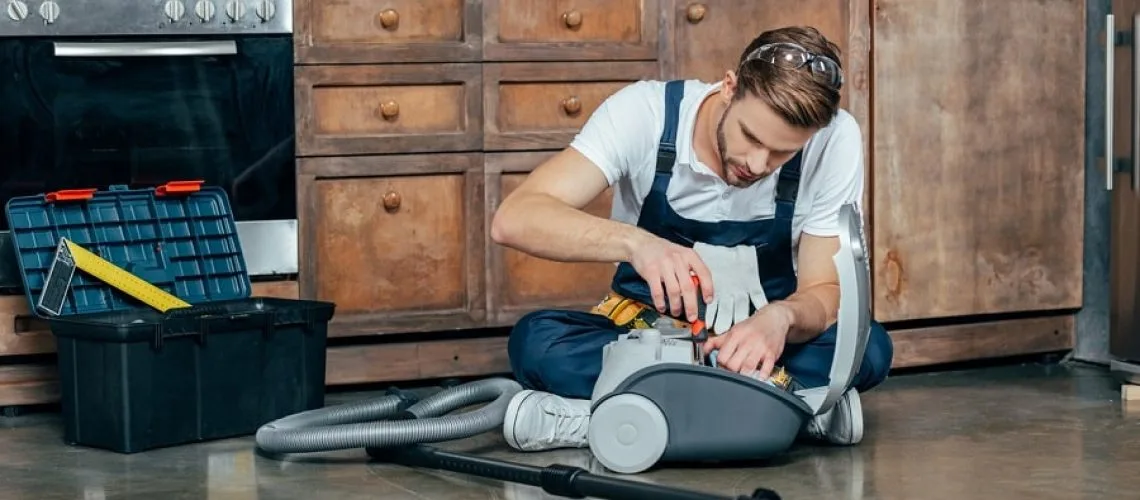Seeing smoke coming out of your vacuum cleaner can be alarming. However, this issue is more common than you may think. If your vacuum starts smoking, don’t panic. In most cases, the problem is fixable with some troubleshooting and maintenance. Rest assured you’re not alone in experiencing a smoking vacuum.
Reasons for Vacuum Smoking
One of the most common reasons a vacuum cleaner may start smoking is that the filters have become clogged or the dust bag is full. When a vacuum sucks in dirt and debris, it needs somewhere for that stuff to collect so that the air being blown out the back end is clean.
The filters are designed to catch all the fine particles that make it through the initial suction. Over time, they can get so coated in dust and dirt that air can’t flow through them anymore. If the airflow gets blocked but the motor keeps running, the friction can cause the debris on the filters to heat up and start smoking or even catch fire.
Similarly, when the dust bag fills up all the way, it blocks airflow through the vacuum. The bag may still get sucked inward toward the motor but then no air comes out the back end. This will put stress on the motor and can cause it to overheat and smoke as well.
The simple solution to both these issues is regular vacuum maintenance – change filters on schedule and replace full bags. Letting them go too long is what typically causes smoking issues.
Clogged Filters
One of the most common reasons for a vacuum cleaner to start smoking is clogged filters. The filters in a vacuum are responsible for trapping dust and debris as air passes through the vacuum. Over time, the filters can become clogged with dirt, hair, and other particles. When the filters get too clogged, it restricts airflow through the vacuum.
With reduced airflow, the vacuum motor has to work much harder to try to suck in air to operate. All of this extra strain on the motor causes it to overheat. The motor overheating then leads to the burning smell and smoke coming out of the vacuum. Essentially, the clogged filter chokes the motor and leads to overheating issues.
To prevent clogged filters, it’s important to regularly check and replace the filters in your vacuum. Most filters should be replaced every 3-6 months with normal use. If you notice reduced suction power, it’s definitely time to swap the filter. Replacing clogged filters restores proper airflow and prevents the motor from overworking and overheating.
Full Dust Bag
When the dust bag in your vacuum gets too full, it can block airflow through the vacuum. This disruption in airflow can cause the motor to overheat from lack of cooling. As the motor overheats, it may begin smoking or even catch fire in severe cases.
Some signs that your dust bag is too full include:
- Decreased suction power
- Loud noise when running
- Dust spilling out of the vacuum
- Burning smell
If you notice any of these signs, turn the vacuum off immediately. Allow it to fully cool before carefully removing the dust bag. Never handle a smoking or hot vacuum.
The dust bag should be emptied frequently, usually after every use or at least once a week for heavy use. Always use genuine replacement bags made specifically for your model. Overfilling or using cheap, off-brand bags can lead to clogs and overheating issues over time.
Replacing the bag regularly before it gets overly full will help prevent airflow restrictions and motor overheating issues. Check your owner’s manual to see the recommended interval for changing your vacuum’s dust bag. Proper maintenance goes a long way towards extending the life of your vacuum and preventing potentially dangerous overheating issues.
Belts and Brushes
If your vacuum cleaner’s belts become worn or damaged, they can start to slip on the motor shaft and cause friction and overheating. This friction generates smoke and a burning smell. The most common belts to cause issues are the drive belt, which connects the motor to the brush roller, and the fan belt, which powers the vacuum’s fan.
Signs of a worn drive belt include the brush roller not spinning properly or making grinding noises when vacuuming carpets. The belt can become stretched out, frayed or even snap entirely. A damaged fan belt will cause the vacuum’s fan to stop spinning or spin inconsistently. This reduces suction power.
The brush roller inside the vacuum head has bristles that can also wear out over time. As debris gets embedded in the bristles, it can cause the roller to jam and prevent it from spinning smoothly. The friction from a jammed brush roller can cause the drive belt to slip and smoke. Replacing worn belts and brushes will help prevent overheating issues.
Motor Overheating
One common cause of a vacuum smoking is an overheated motor. This happens when the motor is working too hard, causing it to get extremely hot. There are several issues that can lead to motor overheating:
Lack of maintenance – If you don’t regularly clean the vacuum or change filters, the motor has to work harder to suck up debris. This extra effort causes overheating.
Clogged hose or attachments – Blockages in the hose or attachments force the motor to work harder to pull air through. This strains the motor and leads to overheating.
Worn carbon brushes – The carbon brushes deliver power to the motor. When they wear out, electrical contact becomes inconsistent, making the motor work harder and overheat.
Obstructed air vents – Most vacuums have vents to allow air circulation and prevent overheating. If these vents get blocked, heat can build up and cause the motor to overheat.
Thermal overload switch issues – This safety device shuts off power if the motor overheats. If it’s faulty, the motor can overheat without shutting off.
If the motor is overheating, the vacuum will start smoking and you may notice a burning smell. Avoid running the vacuum to prevent further damage. Inspect the unit and troubleshoot the potential causes. Replacing worn parts like brushes and clearing any blockages can often solve an overheating issue. If not, the motor itself may need professional service or replacement.
Electrical Issues
Electrical issues are another common cause of vacuum smoking. An electrical short or faulty wiring in the vacuum can lead to overheating of the motor or other components. This excessive heat can burn insulation, melt plastic parts, or even ignite debris inside the vacuum.
Some signs of electrical problems include:
- The vacuum suddenly stops working or turns off while in use
- An electrical or “burning” smell coming from the vacuum
- Visible sparks, arcing, or melted wires
- The vacuum only works intermittently or when held a certain way
- Frequent blown fuses or tripped breakers
Electrical shorts most often occur due to damaged power cords, old and cracked wiring inside the vacuum, loose connections, or ungrounded outlets. Using the wrong voltage vacuums on your electrical system can also cause shorts.
If you suspect an electrical issue, do not continue using the vacuum, as this poses a potential fire hazard. Try a different outlet first to see if the problem persists. Examine the power cord and electrical connections for damage. Open up the vacuum to look for any scorched, melted, or cracked wires.
Any evidence of electrical shorts or overheating components requires professional service by a qualified vacuum repair technician. They can diagnose and replace any faulty wiring or electrical parts in the vacuum to get it working safely again. Attempting DIY electrical repairs without proper knowledge is not recommended.
Electrical issues must be corrected to avoid ongoing overheating and potential hazards each time the vacuum is used. While not the most common reason for vacuum smoking, electrical shorts can quickly create a dangerous situation. Getting prompt repairs helps ensure your vacuum functions properly for years to come.
How to Prevent Your Vacuum from Smoking
Proper maintenance is key to preventing your vacuums cleaner from smoking. Here are some tips:
Change the filters regularly. The filters trap dust and debris and can get clogged over time. This restricts airflow and causes the motor to overheat and smoke. Consult your owner’s manual for how often to replace filters. Some need changing every 3-6 months.
Don’t overfill the dust bag. A bag that’s too full puts strain on the motor. Empty it when it reaches the “full” line, or change disposable bags frequently.
Inspect the belts and brushes. Worn or broken belts and brushes can prevent the vacuum from working properly, leading to overheating. Replace belts and brushes as needed.
Clean the hose, wand, and attachments. Blockages in these areas reduce suction power and airflow. Use a stiff brush to remove embedded dirt and hair.
Following the manufacturer’s maintenance schedule for your specific model is the best way to prevent problems like smoking motors. A little preventive care goes a long way in keeping your vacuum running smoothly.
When to Call a Repair Person
If your vacuum cleaner is smoking even after you’ve cleaned or replaced the filters, emptied the dust bag, cleared any clogs, and checked the belts and brushes, it likely requires professional repair. Some signs that indicate it’s time to call for service include:
The vacuum continues smoking heavily or emitting a burning smell after basic maintenance. This suggests an internal issue like a worn-out motor or electrical problem. Prolonged overheating can cause permanent damage.
You’ve replaced the filters and emptied the dust bag but the vacuum still doesn’t have strong suction. There could be a clog deep in the air channels that you can’t access. Lack of suction can also be caused by problems with the motor or fan.
The vacuum makes loud, unusual noises when running. This points to an issue with the motor, fan, or bearings that requires disassembly to fix. Strange noises mean something is wrong internally.
You spot sparks or burned areas when inspecting the vacuum. Any sign of electrical damage or scorching indicates a short circuit or dangerous wiring issue. This is a fire hazard and needs immediate repair.
The vacuum won’t turn on at all, even after checking the power cord connections. There may be an internal electrical failure or a problem with the motor or switch.
Only attempt DIY repairs if you’re knowledgeable about vacuums cleaner electrical and mechanical systems. For smoking issues or complex problems, it’s safest to have a professional service technician inspect and fix your vacuum to avoid injuries or further damage.
Conclusion
Keeping your vacuum cleaner in good working order through regular maintenance and cleaning is crucial to prevent issues like smoking. Smoking is often a sign of a problem that needs to be addressed. Recapping the main points, a vacuum can start smoking due to several key reasons:
Clogged filters prevent proper airflow and cause overheating. Clean or replace filters regularly.
A full dust bag or dirt container blocks suction. Empty the bag or container when full.
Worn belts and brushes can slip and cause friction and overheating. Inspect and replace belts/brushes as needed.
Motor overheating from lack of maintenance/clogged vents. Clean vents and motor, don’t overwork vacuum.
Electrical issues like worn wires or bad connections can lead to overheating/sparking. Have an expert inspect electrical components if needed.
With proper use and routine care, most smoking issues can be avoided. But if smoking persists after troubleshooting, have the vacuums serviced by a professional repair technician to identify and fix the underlying problem. Maintaining your vacuum is important to keep it working safely and effectively.

